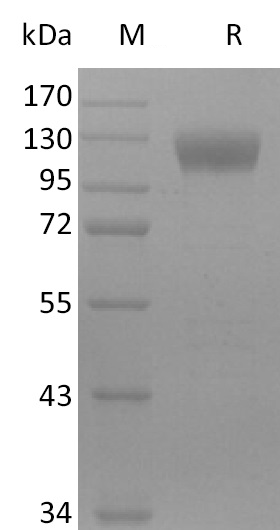Shopping Cart
Remove All Your shopping cart is currently empty
Your shopping cart is currently empty
Siglec-10 Protein, Mouse, Recombinant (hFc) is expressed in HEK293 mammalian cells with C-Fc tag. The predicted molecular weight is 110-135 KDa and the accession number is Q80ZE3.

| Pack Size | Price | USA Warehouse | Global Warehouse | Quantity |
|---|---|---|---|---|
| 5 μg | $64 | 4-6 weeks | 4-6 weeks | |
| 10 μg | $102 | 4-6 weeks | 4-6 weeks | |
| 20 μg | $163 | 4-6 weeks | 4-6 weeks | |
| 50 μg | $310 | 4-6 weeks | 4-6 weeks | |
| 100 μg | $558 | 4-6 weeks | 4-6 weeks | |
| 200 μg | $987 | 4-6 weeks | 4-6 weeks | |
| 500 μg | $2,230 | 4-6 weeks | 4-6 weeks | |
| 1 mg | $3,350 | 4-6 weeks | 4-6 weeks |
| Biological Activity | Activity has not been tested. It is theoretically active, but we cannot guarantee it. If you require protein activity, we recommend choosing the eukaryotic expression version first. |
| Description | Siglec-10 Protein, Mouse, Recombinant (hFc) is expressed in HEK293 mammalian cells with C-Fc tag. The predicted molecular weight is 110-135 KDa and the accession number is Q80ZE3. |
| Species | Mouse |
| Expression System | HEK293 Cells |
| Tag | C-hFc |
| Accession Number | Q80ZE3 |
| Synonyms | SLG2sialic acid binding Ig-like lectin 10 Ig-like lectin 7,SLG2,Siglec-like protein 2,siglec-like gene 2,Siglec-G,SiglecG,Siglec-10,Siglec10,sialic acid-binding Ig-like lectin 10,PRO940,MGC126774 |
| Amino Acid | Met19-Lys543 |
| Construction | Met19-Lys543 |
| Protein Purity | Greater than 95% as determined by reducing SDS-PAGE. (QC verified)  |
| Molecular Weight | 110-135 KDa (reducing condition) |
| Endotoxin | < 0.1 ng/µg (1 EU/µg) as determined by LAL test. |
| Formulation | Lyophilized from a solution filtered through a 0.22 μm filter, containing PBS, pH 7.4. |
| Reconstitution | Reconstitute the lyophilized protein in distilled water. The product concentration should not be less than 100 μg/ml. Before opening, centrifuge the tube to collect powder at the bottom. After adding the reconstitution buffer, avoid vortexing or pipetting for mixing. |
| Stability & Storage | Lyophilized powders can be stably stored for over 12 months, while liquid products can be stored for 6-12 months at -80°C. For reconstituted protein solutions, the solution can be stored at -20°C to -80°C for at least 3 months. Please avoid multiple freeze-thaw cycles and store products in aliquots. |
| Shipping | In general, Lyophilized powders are shipping with blue ice. Solutions are shipping with dry ice. |
| Research Background | Siglecs (sialic acid binding Ig-like lectins) are I-type lectins that belong to the immunoglobulin superfamily. They are characterized by an N-terminal Ig-like V-type domain which mediates sialic acid binding, followed by a varying number of Ig-like C2-type domains. Siglecs 5-11 constitute the CD33/Siglec-3 related group, and are differentially expressed in the hematopoietic system. Siglec-G is the apparent ortholog of human Siglec-10. We describe here a novel member of the siglec protein family that shares a similar structure including five Ig-like domains, a transmembrane domain, and a cytoplasmic tail containing two ITIM-signaling motifs. Siglec-10 was identified through database mining of an asthmatic eosinophil EST library. Siglec-10 binds sialated proteins and lipids in alpha 2,3 or alpha 2,6 linkage and shows a preference for GT1b gangliosides. This binding can be modulated by cis interactions of Siglec-10 with sialated molecules expressed on the same cell. When tyrosine phosphorylated, the cytoplasmic ITIMs interact with phosphatases SHP-1 and SHP-2 to propagate inhibitory signals. The Siglec-10-VAP-1 interaction seems to mediate lymphocyte adhesion to endothelium and has the potential to modify the inflammatory microenvironment via the enzymatic end products. |
| Size | Quantity | Unit Price | Amount | Operation |
|---|

Copyright © 2015-2026 TargetMol Chemicals Inc. All Rights Reserved.